

JavaScript 之旅 (2):Array.prototype.includes()
source link: https://titangene.github.io/article/javascript-array-includes.html
Go to the source link to view the article. You can view the picture content, updated content and better typesetting reading experience. If the link is broken, please click the button below to view the snapshot at that time.


常會有找出陣列中是否包含某元素的需求,過去會使用 Array.prototype.indexOf() 來處理,但在 ES2016 (ES7) 提供了 Array.prototype.includes() 新的 Array method,更方便好用,那這兩個差在哪?解決過去的哪些問題?讓我們從 ECMAScript spec 中一探究竟吧。
本文同步發表於 iT 邦幫忙:JavaScript 之旅 (2):Array.prototype.includes()
「JavaScript 之旅」系列文章發文於:
過去的 Array.prototype.indexOf()
若要確定陣列內是否包含某元素,過去常見的作法是使用 Array.prototype.indexOf(),你應該有看過這幾種寫法:
1
2
3
4
5
6
7
8
9
10
11
let array = ['JS', 'ECMA', 'TC39'];
let searchElement = 'ECMA';
console.log(array.indexOf(searchElement) !== -1); // true
console.log(array.indexOf(searchElement) >= 0); // true
if (~array.indexOf(searchElement)) {
console.log('找到啦!'); // 找到啦!
} else {
console.log('找不到 QQ');
}
利用 Array.prototype.indexOf() 回傳的 index 來確定陣列內是否包含該元素:
- 回傳
-1代表陣列內沒有該元素 - 否則就是找到的元素的 index 值
但這些寫法有一些問題:
- 不直覺:需透過
Array.prototype.indexOf()來問該元素在陣列中第一次被找到的 index 為何,然後使用比較運算子 (即===、>=等) 或位元運算子 (即~) 來確定該元素是否存在 - 寫法不統一:每個人對於比較運算子的使用習慣不同,有些人會用
!== -1,有些人會用>= 0… 等,但明明都是一樣的行為 - 不適用於
NaN:因為Array.prototype.indexOf()是用嚴格相等來比較,而NaN !== NaN(NaN本來就不等於自己),所以你無法在陣列中找出NaN
1
console.log([NaN].indexOf(NaN) !== -1); // false
現代的 Array.prototype.includes()
於是在 ES2016 (ES7) 提供了 Array.prototype.includes() 新的 Array method,不用管陣列的 index,直接就會回傳是否包含該元素的 Boolean 值,true 代表包含,false 則代表不包含,非常直覺又方便:
1
2
3
4
let array = ['JS', 'ECMA', 'TC39'];
let searchElement = 'ECMA';
console.log(array.includes(searchElement)); // true
而且也可以解決 NaN 的問題:
1
console.log([NaN].includes(NaN)); // true
後面會解釋
Array.prototype.includes()是如何解決NaN的問題,spec 其實都有告訴你!
另外為了一致性,Array.prototype.includes() 的參數用法跟 Array.prototype.indexOf() 的一樣,下面是他們的語法:
1
2
Array.prototype.indexOf(searchElement[, fromIndex])
Array.prototype.includes(searchElement[, fromIndex])
註:
[, fromIndex]中的[]不是代表陣列,在語法表示法中代表的是可選參數,而Array.prototype.includes()和Array.prototype.indexOf()的可選參數fromIndex預設為0,代表會從陣列的最前面開始尋找符合的元素。
兩者實際使用的行為一樣 (除了剛剛提到的 NaN 之外):
1
2
3
4
5
let array = ['JS', 'ECMA', 'TC39', 'JS', 'ECMA'];
let searchElement = 'JS';
console.log(array.indexOf(searchElement, 2) !== -1); // true
console.log(array.includes(searchElement, 2)); // true
關於為什麼
includes()要命名成includes,而不是has或contains,可參閱 tc39/Array.prototype.includes 的 FAQ。
spec 定義
Array.prototype.indexOf() 的 spec 定義
先來看看 Array.prototype.indexOf() 在 spec 的定義:
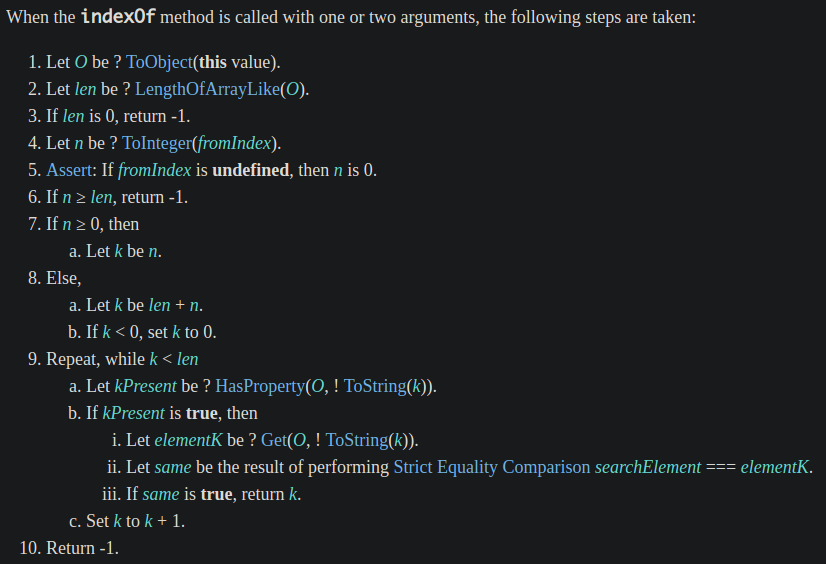
大致上就是從陣列中找出與 searchElement match 的元素,用嚴格相等比較 (Strict Equality Comparison) 來確認 searchElement 是否與陣列中的某元素相同。
在 spec 定義的 1~6 步驟明確說明,何時才會真正開始從陣列中尋找 match 的元素,在某些條件下會直接回傳
-1,例如:陣列的 length 等於 0,或是fromIndex的值大於陣列的 length 的時候。
Array.prototype.includes() 的 spec 定義
接著來看 Array.prototype.includes() 在 spec 的定義:
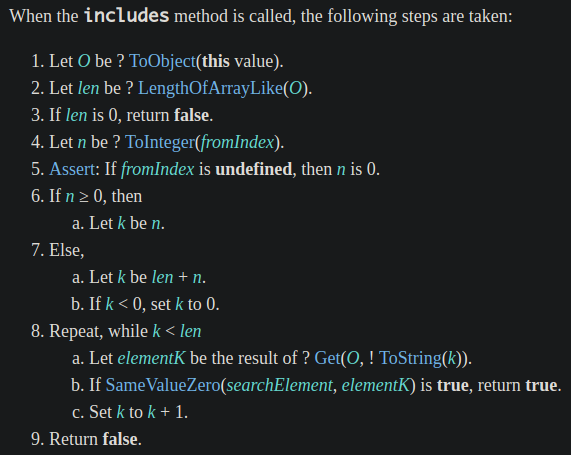
大致上的定義和 Array.prototype.indexOf() 非常像,但有一些不同:
- 回傳值變成 Boolean 值,而不是 index 值 (型別為 Number)
- 在比對
searchElement是否 match 陣列中的元素時,使用的是 SameValueZero 演算法,而不是嚴格相等比較- 透過 SameValueZero 演算法可以找出陣列中的
NaN元素
- 透過 SameValueZero 演算法可以找出陣列中的
- 不會跳過空缺的陣列元素 (即 empty slot),而是視為
undefined(所以Array.prototype.indexOf()會跳過 empty slot,因為它在 spec 定義的步驟 9.a,只要沒有該 property 就會直接跳過,繼續比對下一個元素)
1
2
3
4
5
6
7
8
9
let array = Array(3);
console.log(array); // [empty × 3]
console.log(array.indexOf() !== -1); // false
console.log(array.includes()); // true
console.log(array.indexOf(undefined) !== -1); // false
console.log(array.includes(undefined)); // true
看完 Array.prototype.indexOf() 和 Array.prototype.includes() 的定義之後,讓我們更深入看前者使用的嚴格相等比較 (Strict Equality Comparison) 和後者使用的 SameValueZero 演算法在 spec 中是如何定義的。
嚴格相等比較 vs. SameValueZero
嚴格相等比較 的 spec 定義
先來看 Array.prototype.indexOf() 使用的嚴格相等比較 (Strict Equality Comparison) 在 spec 的定義:

嚴格相等比較會先比較型別是否相同,不同就回傳 false。
然後,如果型別是 Number 或 BigInt 就會直接進行值的比較。Number::equal 的定義如下:
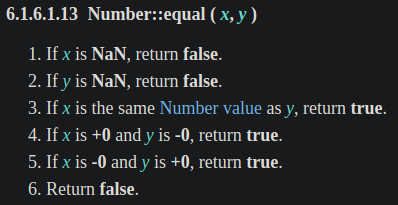
在步驟 1 和 2 提到,只要值是
NaN就會回傳false,這就是NaN不等於NaN的原因
回到嚴格相等比較的步驟 3:否則,其他型別會使用 SameValueNonNumeric 演算法,spec 的定義如下:
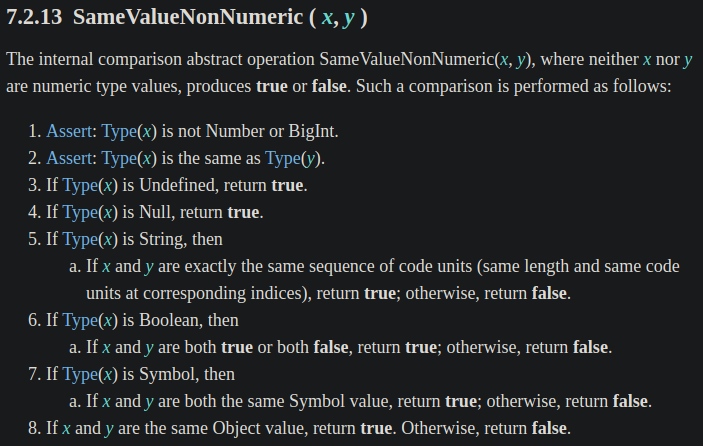
- 值為
null或undefined時會回傳true String型別就比對字串Boolean、Symbol和Object型別都是比較值是否相同 (但 Object 型別的值必須是同一個參考)
如果元素的型別為 Object,值看起來相同,但參考不同時,Array.prototype.indexOf() 和 Array.prototype.includes() 都會找不到一樣的元素 (ECMAScript 表示:啊就真的不一樣啊):
1
2
3
4
let array = [{id: 1}, {id: 2}, {id: 3}];
console.log(array.indexOf({id: 2}) !== -1); // false
console.log(array.includes({id: 2})); // false
如果是同一個物件參考,就會找到 match 的元素:
1
2
3
4
5
let item = {id: 2};
let array = [{id: 1}, item, {id: 3}];
console.log(array.indexOf(item) !== -1); // true
console.log(array.includes(item)); // true
SameValueZero 的 spec 定義
接著來看 Array.prototype.includes() 使用的 SameValueZero 演算法在 spec 的定義:
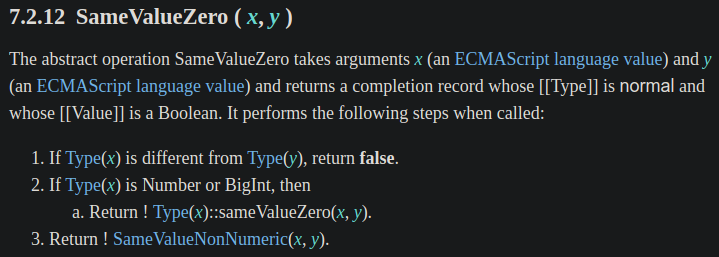
步驟 1 和嚴格相等比較一樣,會先比較型別是否相同,不同就回傳 false。
然後,如果型別是 Number 或 BigInt 就會進行 Type(x)::sameValueZero(x, y) 來比較。那 Type(x)::sameValueZero(x, y) 是啥?其實在 spec 內定義,Number 或 BigInt 型別都是 ECMAScript 內建的 Numeric 型別,而每種內建型別會定義很多 operations,其中的就是 T::sameValueZero(x, y):
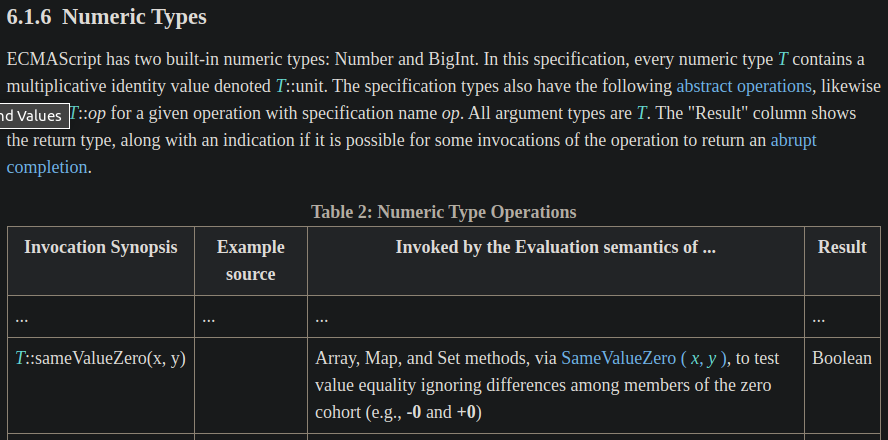
註:因為表格有太多內容了,所以我把這次不會提到的內容都變成
...了。
接著往下找就會看到詳細的定義:

在步驟 1 提到,只要兩個比較的值都是
NaN,就會回傳true,這就是Array.prototype.includes()解決NaN不等於NaN這個問題的步驟。
回到嚴格相等比較的步驟 3:否則,使用 SameValueNonNumeric 演算法,因為上面提到了,就不重複說明囉。
polyfill
下面是 MDN 提供的 polyfill,若跟 spec 相比可以發現簡化一些東西,但大致上的結果會相同:
1
2
3
4
5
6
7
8
9
10
11
12
13
14
15
16
17
18
19
20
21
22
23
24
25
26
27
28
29
30
31
32
33
34
35
36
37
38
39
40
41
42
43
44
45
46
47
48
49
50
51
52
53
// ref: https://developer.mozilla.org/zh-TW/docs/Web/JavaScript/Reference/Global_Objects/Array/includes#Polyfill
if (!Array.prototype.includes) {
Object.defineProperty(Array.prototype, 'includes', {
value: function(searchElement, fromIndex) {
if (this == null) {
throw new TypeError('"this" is null or not defined');
}
// 1. Let O be ? ToObject(this value).
var o = Object(this);
// 2. Let len be ? LengthOfArrayLike(O)
// 即 Let len be ? ToLength(? Get(O, "length")).
var len = o.length >>> 0;
// 3. If len is 0, return false.
if (len === 0) return false;
// 4. Let n be ? ToInteger(fromIndex).
// 5. Assert: If fromIndex is undefined, this n is 0.
var n = fromIndex | 0;
// 6. If n >= 0, then
// a. Let k be n.
// 7. Else n < 0,
// a. Let k be len + n.
// b. If k < 0, set k to 0.
var k = Math.max(n >= 0 ? n : len - Math.abs(n), 0);
function sameValueZero(x, y) {
return (
x === y || (
typeof x === 'number' && typeof y === 'number' &&
isNaN(x) && isNaN(y)
)
);
}
// 8. Repeat, while k < len
while (k < len) {
// a. Let elementK be the result of ? Get(O, ! ToString(k)).
// b. If SameValueZero(searchElement, elementK) is true, return true.
if (sameValueZero(o[k], searchElement)) return true;
// c. Set k to k + 1.
k++;
}
// 9. Return false
return false;
}
});
}
其他 polyfill:
資料來源:
Recommend
About Joyk
Aggregate valuable and interesting links.
Joyk means Joy of geeK